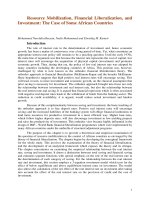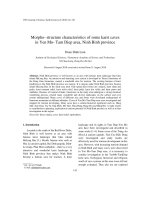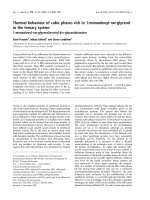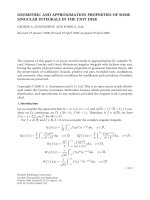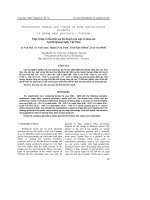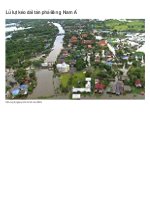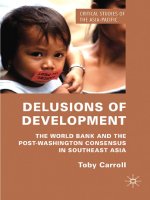Saving behaviour of some developing countries in southeast asia
Bạn đang xem bản rút gọn của tài liệu. Xem và tải ngay bản đầy đủ của tài liệu tại đây (1.46 MB, 76 trang )
UNIVERSITY OF ECONOMICS
HO CHI MINH CITY
VIETNAM
INSTITUTE OF SOCIAL STUDIES
THE HAGUE
THE NETHERLANDS
VIETNAM - NETHERLANDS
PROGRAMME FOR M.A IN DEVELOPMENT ECONOMICS
VIETNAM ECONOMIC GROWTH AND SAVING
ANALYSIS IN THE PERIOD 1989 - 2012
BY
LE DUC ANH
MASTER OF ARTS IN DEVELOPMENT ECONOMICS
HO CHI MINH CITY, DECEMBER 2014
UNIVERSITY OF ECONOMICS
INSTITUTE OF SOCIAL STUDIES
HO CHI MINH CITY
VIETNAM
THE HAGUE
THE NETHERLANDS
VIETNAM - NETHERLANDS
PROGRAMME FOR M.A IN DEVELOPMENT ECONOMICS
VIETNAM ECONOMIC GROWTH AND SAVING
ANALYSIS IN THE PERIOD 1989 - 2012
A thesis submitted in partial fulfilment of the requirements for the degree of
MASTER OF ARTS IN DEVELOPMENT ECONOMICS
By
Le Duc Anh
Academic Supervisor:
Dr. Dinh Cong Khai
HO CHI MINH CITY, DECEMBER 2014
Acknowledgement
Foremost, I would like to express my sincere gratitude to my supervisor Dr. Dinh Cong
Khai for the continuous support of my M.A study and research, for his patience,
motivation, enthusiasm and immense knowledge. His guidance helped me in all the
time of research and writing of this thesis.
Besides my supervisor, I would like to thank VNP teaching staff for their
encouragement, insightful comments, and hard questions.
Last but not the least, I would like to thank my family: my parents, my wife and my
brothers for supporting me spiritually throughout my life.
OUTLINE
Abstract.......................................................................................................................................... 1
Chapter 1: Introduction ............................................................................................................... 2
1.1
Problem statement ........................................................................................................ 2
1.2
Research objectives ...................................................................................................... 5
1.3
Research questions ....................................................................................................... 5
1.4
Methodology ................................................................................................................ 6
1.5
Research scope ............................................................................................................. 6
1.6
Structure of the study ................................................................................................... 6
Chapter 2: Literature Review ...................................................................................................... 7
2.1
Theoretical literature .................................................................................................... 7
2.2
Empirical literature..................................................................................................... 10
2.3
Conceptual framework ............................................................................................... 18
Chapter 3: Research Methodology ............................................................................................ 20
3.1
Data collection ........................................................................................................... 20
3.2
Unit root test ............................................................................................................... 21
3.3
Cointegration analysis ................................................................................................ 23
3.4
Granger causality analysis.......................................................................................... 24
Chapter 4: Empirical Analysis .................................................................................................. 26
4.1
Empirical evidence ..................................................................................................... 26
4.1.1
Unit root test results ........................................................................................... 26
4.1.2
Cointegration test results .................................................................................... 28
4.1.3
Granger causality test results ............................................................................. 30
4.2
Discussion of findings ................................................................................................ 33
Chapter 5: Concluding Remarks............................................................................................... 40
References
Appendix
LIST OF TABLES AND FIGURES
Figures
Figure 1: Relationship between saving and economic growth stated by Solow (1956) ..... 8
Figure 2: The grapth of LGDP, LGDS and LFDI series ................................................ 26
Tables
Table 1: The summary of the main empirical studies ..................................................... 13
Table 2: Unit root test of variables at level value ........................................................... 27
Table 3: Unit root test of variables at the first difference ............................................... 28
Table 4: Results of ARDL bound test ............................................................................ 29
Table 5: Estimated long run coefficients using the conditional ARDL(2, 0, 0) ............... 30
Table 6: Results of VECM based on error terms taken from the conditional ARDL ...... 31
Table 7: Results of diagnostic tests for equation 11 ....................................................... 32
Table 8: Results of short-run Granger causality ............................................................ 33
Table 9: Average values of FDI, GDP and GDS in three stages ..................................... 34
Table 10: Commercial bank network density ................................................................. 36
Table 11: Average percentage of rural population over total population in three stages . 36
Table 12: Vietnam stock market in the period 2006 – 2012 ........................................... 37
LIST OF ABBREVIATIONS
Abbreviation
Meaning
ADF
Augmented Dickey-Fuller test
AIC
Akaike Information Criterion
ARDL
Autoregressive Distributed Lag
ASEAN
Association of Southeast Asian Nations
ECT
Error Correction Term
FDI
Foreign Direct Investment
GDP
Gross Domestic Product
GDS
Gross Domestic Saving
LGDP
Logarithm of Gross Domestic Product
LGDS
Logarithm of Gross Domestic Saving
LFDI
Logarithm of Foreign Direct Investment
OLS
Ordinary Least Squares
PP
Phillips-Perron test
VECM
Vector Error Correction Method
WTO
World Trade Organization
VIETNAM ECONOMIC GROWTH AND SAVING ANALYSIS IN THE
PERIOD 1989 – 2012
Abstract
This paper employs Autoregressive-Distributed Lag model to detect the cointegrating
vectors amongst three variables that are gross domestic saving per capita, gross
domestic product per capita and foreign direct investment being stationary at the
mixture of I(0) and I(1) in the period 1989 – 2012. The results do not support for the
hypothesis as Solow (1956) states in which domestic saving and foreign direct
investment are sources for domestic investments, then push economic growth. The long
run relationship amongst these indicators is consistent with some recent empirical
studies for the case of developing countries. That is, the long run causal direction
running from economic growth to domestic saving. Additionally, foreign direct
investment does not cause economic growth in both short and long run, but tends to
reduce domestic saving in long run.
Furthermore, combining the estimated results with some statistical measurements of
demographic change in total population and financial market development gives to us
evidences in which financial market in Vietnam is still weak, thus does not strengthen
the channel of domestic private saving accumulation, especially from huge amount of
rural population. FDI has increased annually, but it only takes a small percentage in
GDP. As a result, there is no evidence to support for the nexus from saving to growth.
GDS increasing annually is explained by a rise of GDP, and perhaps by some positive
demographic change in total population. Last but not the least, in long run FDI tends to
reduce domestic saving due to ineffective channel of domestic capital accumulation,
especially for Vietnam stock market. Then, it casts doubts on an assumption of Solow
about the positive nexus running from saving to growth, especially for developing
countries.
1
Chapter 1: Introduction
In this chapter, the study presents the reason of choosing this kind of research for the
specific case of Vietnam to analyze the interaction amongst domestic saving, foreign
direct investment and economic growth in the period 1989 – 2012.
1.1 Problem statement
The central assumption of the Solow’s (1956) growth model is a positive nexus
between saving rate and economic growth in which saving rate plays a role of
conditional factor to push growth. This model implies some policy implications for a
country to concentrate on increasing saving, thus economic growth will increase in
response. However, inversely if there is a possibility of negative impact, a country shall
focus on removing barriers to growth instead of accumulating saving.
There are some robust empirical findings about the positive association between saving
and growth. Nevertheless, this correlation does not imply a causal direction amongst
them, and then this controversy is still unsolved. Moreover, the debate concerning with
the priority of policy implication for these indicators is an important issue raised at the
current macroeconomics, as stated by Schmidt-Hebbel et al (1996). Hence, determining
the causal direction of saving-growth linkage is crucial, and has many implications for
policy makers in developing countries.
At the notion of growth to saving, it has been supported by some empirical evidences
of several recent studies analyzing in developing countries. For instance, in the
research by Ramesh (2006), he finds that in the group of low-middle income countries
there is mostly the causal direction from growth to saving. Furthermore, the study by
Pradeep, Pravakar, and Ranjan (2008) also shows the empirical evidences from 5
countries – Bangladesh, India, Pakistan, Srilanka and Nepal – there is a causal
2
direction from growth to saving, however, only Bangladesh with bi-directional
causality.
In an open economy, two capital sources contributing to domestic investment are
domestic and foreign saving. With foreign saving, it is represented by some forms of
international capital inflows. Theoretically, these inflows are assumed to be additive, or
supplement domestic saving to increase an amount of investment, hence to push
economic growth. This hypothesis is seemingly relevant in some certain capital
inflows, especially to foreign direct investment (noted as FDI) because this inflow is
more stable than the other components of foreign saving in term of predictability and
volatility (Taylor, 1997 and Lipsey, 1999 cited in Maite, Ana and Vicente, 2004). In
the research composed by Matie, Ana and Vicente (2004), they analyze the role of FDI
to the nexus between economic growth and domestic saving in Mexico and find that
FDI causes both GDP and GDS positively, hence to reinforce the relationship between
economic growth and domestic saving. However, this hypothesis does not hold in the
study by Ahmad, Marwan and Salim (2002) for the case of Malaysia, Thailand and
Philippines. They find foreign savings affecting domestic saving negatively in both
short and long run. Moreover, in long run the causal direction runs from foreign to
domestic saving, but the inverse direction does not exist.
In the history, Latin America crisis happened in Mexico after the peso was devaluated
by the authorities in 1994, then quickly spreading to several other countries in this
region. Consequently, a huge amount of capital outflow left these countries into
shambles. However, on the contrary to that of Latin America countries, East Asian
economies were not seriously affected by the crisis. Then, based on this fact, some
economists conclude that Latin America countries were more sensitive to the shift of
investor sentiments and the fluctuation of international capital outflows than Asian
countries. This difference relates to domestic saving rate in which the higher the
3
domestic saving in a country is, therefore can reduce the international capital outflows’
influence through a crisis. Furthermore, in this period, an increase of foreign
investment in East Asian countries correlated with a huge decrease of domestic saving
rate in Latin America countries.
In the mid of year 1997, the Asian crisis started from Thailand, then influenced to
several other countries. Based on this fact, it casts doubts on the economic notion held
earlier through Latin America crisis by some economists. The Asian economies’
currencies were devaluated sharply, then leading to a massive outflow of foreign
capital at the end of year 1997. On the other hand, the experience was similar with the
case of Latin America crisis. The retreat of foreign capital emphasizes the necessity of
more domestic financing seen as a complement to that decline in capital. As
dramatized by Latin America and Asian crisis, therefore, it is important to analyze the
nexus between domestic and foreign saving because foreign capital could be
withdrawn as easily as it enters, consequently a domestic economy could be left into
shambles through a crisis.
In recent years, Vietnam’s economy has succeeded in the new stage of development
after opening the economy in 1988. Especially, Vietnam has been a member of
ASEAN since 1995, and WTO since 2007. Then, its economic growth has increased
rapidly in the period 1989 – 2012. Tariffs and trade barriers have been reduced step by
step amongst members in ASEAN and WTO, therefore, Vietnam’s trade balance has
been improved as well. From a poor country with per capita income only equals to 290
U.S dollars a year in 1989, Vietnam has reached to nearly 1000 U.S dollars a year in
2012. Moreover, domestic saving rate and foreign direct investment in Vietnam have
also increased annually through this period. In detail, its gross domestic saving has
changed from 0.837 to 26.9 billion U.S dollars, and FDI has also moved from 0.01 to
4.7 billion U.S dollars, respectively in 1989 and 2012 (World Bank Indicators, 2012).
4
Recently, almost empirical studies for developing countries show the results that the
causal direction runs from economic growth to domestic saving, however, the role of
FDI to the relationship is still ambiguous. Additionally, there is a lack of empirical
evidences for the specific case of Vietnam, thus we choose this research topic to
answer what kind of relationship stands behind the upward movement amongst these
indicators in the period, 1989 – 2012.
1.2 Research objectives
As some issues mentioned on the problem statement above, they cast an empirical
research objective to analyze whether or not the hypothesis of saving – growth nexus
composed by Solow (1956) holds for the case of Vietnam. Moreover, in an open
economy foreign capital inflows play an important role to increase income. Therefore,
we want to measure the effect of domestic saving to economic growth with an addition
of foreign direct investment seen as a component of foreign saving. On the other hand,
it means that the study will analyze whether or not domestic and foreign saving are
sources to affect income positively as Solow (1956)’s hypothesis mentions. Finally
based on this estimated result, the study will suggest some policy implications for the
specific case of Vietnam that relate to the saving and growth relationship.
1.3 Research questions
As the research objective mentioned above, the study will deal with the research
question in which: Could an increase of economic growth in Vietnam for years 1989 to
2012 be explained by the higher saving rate and FDI?, on the other hand, it means the
long run causal direction running from domestic saving and FDI to economic growth
that exists or not.
5
1.4 Methodology
Due to the specification of Vietnam’s data set in the period 1989 – 2012 (discussed in
detail at Chapter 4), thus ARDL cointegration bound test is employed to detect a longterm cointegration amongst GDS, GDP and FDI. Based on the results of the bound test,
we will employ VECM to estimate short term and long term nexus between these
variables. Finally, to make the findings more robust, we must combine the estimated
results with the statistical measurement of some relevant indicators in the discussion.
1.5 Research scope
The research aims at interpreting an interaction amongst the three Vietnam economic
indicators that are GDP, GDS and FDI in the period 1989 – 2012. The analysis
concentrates on dealing with the research questions raised above. Furthermore, because
the time series span of Vietnam data is limited, then it is important to note that some
more relevant variables could not be added into the estimation to analyze the
interaction between economic growth and domestic saving, but only FDI (Modigliani,
1970; McKinnon and Shaw, 1973).
1.6 Structure of the study
The study includes five chapters in which: The first chapter presents the problem
statement, research objectives and research questions. The scope of study is also
stressed at this chapter. The second chapter presents the relevant theoretical and
empirical literatures, and the conceptual framework is built on this background. The
third chapter is the research methodology that includes the necessary econometric
techniques could be employed to deal with the research question corresponding to the
specification of data set. In the fourth chapter, the estimated results will be presented
and discussed. The fifth chapter, the study will summarize the empirical findings.
Finally, we will suggest some further research based on the study’s limitations.
6
Chapter 2: Literature Review
In this chapter, the study summarizes the relevant theoretical and empirical studies that
support for the research objectives raised above. The empirical literatures are presented
below that concentrate on analyzing the relationship amongst the three indicators –
domestic saving, economic growth and foreign direct investment – in developing
countries to give some empirical evidences that are expected to contribute for the case
of Vietnam.
2.1 Theoretical literature
There are two relations that link between economic growth and saving: the first relation
is represented by aggregate production function in which a higher capital stock leads to
an increase of output. The second relation is based on a condition of saving and
investment equilibrium, thereby a higher saving rate will definitely increase investment
or capital accumulation, then output level will be higher.
At the first relation, the Solow growth model has a linearly homogeneous production
function of the form 𝑌 = 𝐹(𝐿, 𝐾), where Y is output, K is capital and L is labor.
Moreover, the production function in form of labor intensive that is written as 𝑦 =
𝑓(𝑘) in which k is the capital-labor ratio and equals to 𝑘 = 𝐾/𝐿. There is an
assumption which marginal product of capital is positive but decreasing, written as
𝑓 ′ (𝑘 ) > 0, 𝑓 ′′ (𝑘 ) < 0. Furthermore, the labor force is also assumed to grow at a
constant rate gL. As the model above, the condition for the steady state or equilibrium
𝑔
to occur that is 𝑓(𝑘 ) = ( 𝐿) 𝑘, where s is known as the saving rate. While 𝑓(𝑘)
𝑠
𝑔
measures actual per capita output produced for any capital-labour ratio k, and ( 𝐿) 𝑘
𝑠
represents for the amount of output is necessary to maintain the corresponding capitallabour ratio. If the saving rate increases, as a result it will increase the steady state
7
capital stock per capita, eventually per capita output. In detail, at the point the saving
rate equals to s0, the equilibrium is assumed to be at e0. Then an increase in the saving
rate makes the equilibrium e0 will shift to the new equilibrium, denoted as e0’ (see at
Figure 1 below). Hence, we could see that a saving increase definitely leads to a higher
capital stock per capita, and then to output in steady state.
On the other hand, saving rate increasing will create more per unit investment of
output, in turn leading to expand capital per worker. However, at a given growth rate of
labor, this process comes to a halt because a proportion of investment increase needs to
be kept for maintaining the capital-labor ratio. Thereby, according to the Solow (1956)
growth model, saving rate change will lead to a change in an economy’s balanced
growth path, then to output per capita in steady state, but will not affect the growth rate
of output per worker on the balanced growth path. There is only technological change
that could create a further increase in Y/L at a steady state.
Figure 1: Relationship between saving and economic growth stated by Solow (1956)
(gL/s0’)k
(gL/s0)k
y0’
f(k)
e0’
e0
y0
k0’
k0
8
k
At the second relation, in an open economy the condition of saving and investment
equilibrium seemingly does not exist. As usually, a country can invest more than an
amount of national saving by borrowing from the rest of the world, on the other hand it
means countries running current account deficit. Therefore, this process is written
formally as 𝐼𝑡 = 𝑆𝑡 − 𝐶𝐴𝑡 , where domestic saving and investment are denoted
respectively as St and It , finally CAt is the current account balance.
Moreover, domestic saving is normally a main capital source for domestic investment,
however, foreign saving also plays an important role itself to be a second capital source
of investment in a country. Nevertheless, 𝐼𝑡 = 𝑆𝑡 − 𝐶𝐴𝑡 , does not state any causal
nexus amongst this identity’s components. An exogenous movement of international
capital inflows may affect either of variables in the identity above that depends on
these capital flows’ types such as foreign direct investment, portfolio investment and
other financial flows, then leading to the differences in nature amongst them.
Additionally, there are some empirical studies that prove an existence of different
effects of these types of inflows. As Reinhart (1999) states “there are important
behavioral differences amongst the various types of capital flows, then their effects on
economic activity, such as saving and investment, are also likely to differ”.
In the empirical studies (Bosworth and Collins, 1999; Hausman and Arias, 2000), they
show that FDI affects positively on domestic investment, hence a general belief occurs
to expect that FDI is the most important one. On the other hand, it has been considered
as “good cholesterol” for developing economies. Moreover, in term of volatility and
predictability, FDI is more stable than the other foreign capital inflows, and usually
associates with the managerial and technological know-how transfers. For instance, the
case study of Mexico composed by Matie, Ana and Vicente (2004) shows that FDI
could create the positive spillover for domestic firms to increase their labor
productivity.
9
2.2 Empirical literature
There are some main recent empirical studies that relate to this kind of research and
give the robust empirical findings to support for the analysis. All of these papers
chosen that relate to the research objectives mentioned at Chapter 1 and have analyzed
for the case of developing countries. Especially, there are some evidences taken from
South-East Asian countries having quite the same economic conditions and relations
with Vietnam such as Malaysia, Indonesia, the Philippines and Thailand that could
support the study’s findings.
In the paper by Rubiana, Sunder and Phaninda (2000), a Cobb-Douglas production
function is employed to test whether foreign machinery is more productive than
domestic machinery or not. This study applies a panel model analyzing for seven
countries that are Hong Kong, Singapore, South Korea, Malaysia, Indonesia, the
Philippines and India in the period 1975 – 1990. The empirical evidences show there is
a positive impact of foreign and domestic capital to the national manufacturing
productivity, then to economic growth. Especially in developing countries, the results
show that foreign capital imports go far beyond the effects of foreign capital
investment because they associate with the positive spillover of technology transfers
and high educated worker training on national productivity.
In the paper by Admad, Marwan and Salim (2002), it analyzes the factors that have
influenced the saving behavior in Singapore, South Korea, Malaysia, Thailand and the
Philippines for years 1960 to 1997. Granger causality based on VECM regression for
annual time series was applied in this study for each country to detect both short and
long run effects between relevant explanatory indicators on the saving movement. The
main results include: Firstly, the negative effects from foreign to domestic saving both
in the short and long run. Secondly, Granger causality from saving to economic growth
does not exist, however Singapore is an exception. Thirdly, the mixed effect of interest
10
rate on saving might be due to the differences of financial liberalization adopted
differently across these countries. Finally, there is not to have the long run causality
running domestic saving to foreign saving.
Furthermore, in the study by Dipendra (2002), it analyzes the nexus between saving
and investment rates for Japan and 10 other Asian countries by employing Johansen
cointegration test with the consideration of structural break existence for the specific
data set of each country. The results show the information that saving rate causes the
growth of investment rate for Malaysia, Singapore, Sri Lanka and Thailand. However,
the reverse causality holds for Hong Kong, Malaysia, Myanmar and Singapore. Finally,
the rest of analyzed countries show no evidence of the relationship between saving and
investment rate.
The research composed by Admad and Marwan (2003) identifies the major
determinants of gross national saving ratio in Malaysia. This article applies the
Johansen multivariate cointegration approach followed by the error-correction model to
investigate the saving behavior in a dynamic framework. The paper uses a time span of
1960 – 2000 to analyze the movement of saving and its determinants in Malaysia. The
explanatory variables include economic growth, interest rate, tax rate, export rate,
dependency ratio and foreign direct investment that simultaneously affect to gross
national saving in the analytical model. The statistical evidence reveals that the long
run relationship between saving and its determinants is different from that of short run
dynamics. Specifically, exports and taxes have only temporary effects on the national
saving rate. In addition, evidences found support for the long run effect of interest rate
and demographic ratio on saving that can differ from its short-run. Additionally, there
is a bidirectional nexus between saving rate and economic growth.
The other research composed by Matie et al (2004), employs Granger-non causality
test procedure developed by Toda and Yamamoto (1995) to analyze the saving-growth
11
nexus in Mexico through the period of 1970 – 2000. Empirical results support for the
hypothesis stated by Solow (1956) growth model which higher saving rate leads to an
increase of income. Furthermore, foreign direct investment seen as a main component
of foreign saving seems to be a relevant indicator of the saving-growth nexus when
empirically affecting both domestic saving and economic growth in short and long run.
As a result, an addition of FDI in analytical model confirms and reinforces the
relationship between domestic saving and economic growth.
Additionally, the research composed by Aylit (2005) applies the Johansen
cointegration test followed by VECM estimation technique to analyze the causal
direction between saving and economic growth in South Africa over the period 1946 –
1992. Aggregate private saving is examined to interact with investment and economic
growth. Empirical results show that private saving rate known as a proxy of domestic
saving affects direct, and indirect on economic growth through the private investment
channel. Moreover, economic growth, in turn also positively affects to private saving
rate. On the other hand, there is a cycle of positive interaction between saving rate and
economic growth empirically found for some countries in South Africa.
In the paper by Ramesh (2006), it aims at interpreting the causal relationship between
saving and economic growth in countries with different income levels. This study uses
annual data of GDS and GDP from 25 countries for years 1960 to 2001, and also
divides the countries of interest into 4 groups including low income, low middle, upper
middle and high income. In low income countries, the empirical results are mixed.
However, in low middle income group, almost countries show that the causal direction
runs from economic growth to saving. In all high income countries (Singapore is an
exception), results support for causal relationship moving from economic growth to
saving. And it is very interesting for the empirical results of upper middle income
countries, bi-directional causality for almost countries.
12
The other research by Pradeep, Pravakar and Ranjan (2008) gives some empirical
evidences of the saving behavior in South Asia. This research uses annual data of
saving rate and real income per capita from 5 countries (Bangladesh, India, Pakistan,
Sri Lanka and Nepal) for years 1960 to 2004 by employing VECM and ARDL
methods to detect the interaction between gross domestic saving and its determinants
including economic growth, dependency ratio, the percentage of agriculture to GDP,
inflation rate, M2 per GDP, real interest rate and bank branch density. The results show
that saving movement in South Asian countries are determined by economic growth,
accessibility to banking system, dependency ratio and rate of foreign saving.
Furthermore, the impacts of interest rate on saving are ambiguous and minor when
compared to that of the other components. At last, the causal direction from economic
growth or income to saving is found for mostly analyzed countries, only Bangladesh is
an exception with bi-directional causality.
The last paper presented here is the research by Nurudeen (2010) that empirically
examines the relationship between gross national saving and gross domestic product in
Nigeria for years 1970 to 2007. The estimated result shows these two variables are cointegrated, and exist a long run equilibrium after employing the Johansen cointegration test followed by VECM. In addition, there is the causal direction running
from economic growth to saving.
Table 1: The summary of the main empirical studies
No.
1
Authors
Methodology
Key variables
Rubiana
Pooled cross-
Domestic
The period
et al.
sectional
capital
1975 – 1990 foreign and domestic
(2000)
time-series
investment,
model
foreign
Hong Kong,
productivity and then
capital
Singapore,
output
13
Data
Results
Effective impact of
capital on manufacturing
investment,
South
and labor are
Korea,
explanatory
Malaysia,
variables.
Indonesia,
Dependent is
the
GDP
Philippines
and India
2
Ahmad,
VECM,
GNS, GNP,
Annual
(1) Foreign saving
Marwan
Granger
real interest
time-series
affects domestic saving
and Salim causality and
rate,
in period
negatively in long and
(2002)
time-series
dependency
1970-1997
short run.
OLS
ratio and
Malaysia,
(2) saving does not
regression
current
Thailand,
Granger cause economic
account
the
growth, except
Philippines,
Singapore
Singapore
(3) the effect of interest
and South
rate is mixed
Korea
(4) In long run the
causal direction runs
from foreign to domestic
saving.
3
Dipendra
Johansen
The ratio of
Annual time
(1) Two rates are
(2003)
cointegration
gross
series data.
cointegrated for
test and
domestic
Different
Myanmar and Thailand
VECM
investment to
length of
(2) Saving rate causes
gross
data for each growth of the investment
domestic
country
14
rate for Malaysia,
product and
Singapore, Sri Lanka
the ratio of
Malaysia,
gross
Singapore,
domestic
Sri Lanka,
saving to
Thailand,
gross
Hong Kong,
domestic
Myanmar
product
and
and Thailand.
Singapore
4
Ahmad,
Multivariate
GNS ratio,
Period
(1) Bidirectional nexus
Marwan
cointegration
GDP ratio,
1960-2000
between saving and
(2003)
approach
dependency
in Malaysia
economic growth.
ratio, tax rate,
(2) Long run effect of
export rate,
interest rate and
dependency
demographic ratio on
ratio, foreign
saving but not in short-
direct
run.
investment
(3) saving-interest rate
relation hypothesis is
hold in long run.
5
Matie and Multivariate
Annual series
a period of
(1) GDS and GDP
Ana
causality test,
include GDP,
1970-2000
relation as Solow model
(2004)
Granger non-
GDS and FDI in Mexico
causality test
suggests.
(2)FDI causes both GDP
and GDS then reinforces
these two relations.
15
6
Aylit
VECM
Per capita
Annual time
(1) Private saving rate
(2005)
cointegration
GDP, GDS
series South
has a direct, as well as,
are
Africa
indirect effect on
represented
countries
growth.
by private
The period
(2) Growth positively
investment
1946 – 1992 affecting on private
rate, ratio of
saving rate.
private saving
(3) Bi-directional nexus
to GDP, ratio
between growth and
of
saving.
government
consumption
expenditure
to GDP, real
interest rate
7
Ramesh
Granger
(2006)
causality test
GDS, GDP
Annual
(1) low income group
time-series
results are mixed
in period
(2) low middle income
1960-2001
group results are mostly
25 countries
causal direction from
divided into
growth to saving
4 groups
(3) upper middle income
based on
group results : bi-
their income directional causality
level
(4) high income group
results: almost cases
exist causal direction
16
from growth to saving,
except Singapore
8
Pradeep,
Granger
GDS, Real
A period of
(1) Mixed results about
Pravakar,
causality test,
per capita
1960-2004
the effect of a
and
VECM,
GDP,
Bangladesh,
determinant on saving
Ranjan
Dynamic
inflation rate,
India,
function
(2008)
OLS
dependency
Pakistan, Sri (2) Causal direction
ratio, foreign
Lanka and
from growth to saving,
saving,
Nepal
except Bangladesh with
interest rate,
bi-directional causality
financial
sector
development,
and bank
branch
density
9
Nurudeen Johansen co-
GNS and
Annual data
(1) Existing long run
(2010)
GDP
in Nigeria
equilibrium between
test followed
for years
gross national saving
by VECM,
1970 to
and gross domestic
Granger
2007
product.
integration
causality
(2) Causal direction runs
from growth to saving
17
2.3 Conceptual framework
In the Solow (1956) model, it assumes that higher saving rate will definitely lead to
higher domestic investment financed by two capital resources known as domestic and
foreign saving. Furthermore, in this study, foreign saving is assumed to complement
domestic saving, then will push economic growth through the channel of domestic
investment. These components are expected to positively affect economic growth,
hence the conceptual framework is constructed as below.
Gross Domestic
Product (GDP)
Gross Domestic
Foreign Saving
Saving (GDS)
represented by FDI
As stated by Solow (1956) we should measure domestic saving and economic growth
in a form of per capita unit to capture the population growth effect. Moreover, FDI
seems to be a permanent component of foreign saving when comparing with the other
inflows in terms of volatility and predictability. Therefore, an addition of foreign direct
investment seen as a component of foreign saving, this, then contributes to domestic
investment, in turn pushes economic growth.
Last but not the least, because the nature of cointegration analysis, then with each pair
amongst three variables of interest, the analytical model will measure two possible
causal directions. In the study, with three variables as mentioned above – GDS, FDI
and GDP – we have three pairs of variables, thus conceptual framework is built as
18
shown above. Once more, we should note that even the econometrical method step by
step will estimate all possible cases of causality amongst variables, however, the main
objectives of the study are to focus on interpreting the causal direction from GDS and
FDI to GDP in long run described by dashed lines in the conceptual framework, and
their effects are expected to positively cause GDP.
Finally, it is important to note that in the context of three variable cointegration
analysis, the study will only measure the independent effect of each explanatory
variable on economic growth, according to the research objectives raised above.
Furthermore, the econometric technique employed in this study can’t deal with the
mixed effects of independent variables to the dependent variable.
19
